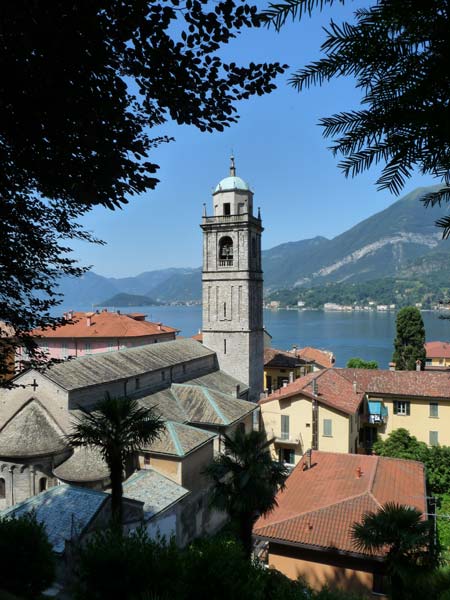About Bellagio
Bellagio is a small village at the tip of a long hilly promontory between the two southern branches of Lake Como. It is an elegant and long-established tourist resort, which still retains considerable charm despite the daily influx of trippers. The historic village of Bellagio only has a population of around 200 (compared to 900 beds for tourists), and most locals live in other hamlets and villages on the headland, all grouped together under the local authority, the Comune di Bellagio. The tiny town is an excellent place to while away an afternoon, to spend a relaxing romantic holiday or simply to base yourself for an exploration of Lake Como. With lovely views, classy boutiques, two gardens to visit, picturesque lanes, a choice of restaurants and bars, and frequent boat services, Bellagio really is one of Italy’s top holiday destinations.
Bellagio tourist information
Bellagio has a helpful tourist information office at the main ferry jetty, where you can pick up maps, information and some good leaflets with suggested walking tours of Bellagio and its neighbouring villages. These leaflets can be downloaded from the efficient tourist information website, which also offers comprehensive information on reaching the resort (see our links on the right).
Bellagio sights and tourist attractions
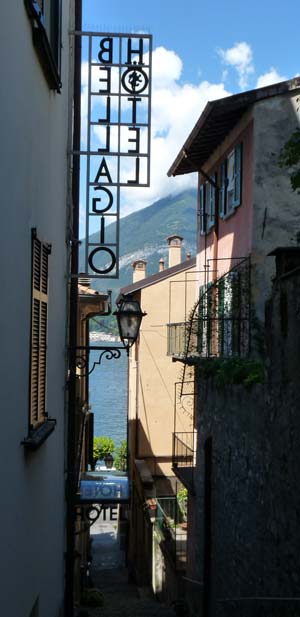
Bellagio is one of the most attractively-situated of the lake resorts, and it is a pleasant place to ramble, explore or simply potter. Passenger ferries stop alongside a tree-lined waterfront. Across the road is a lovely arcade where cafes and restaurants afford shade and shelter from the elements. This is a good place to come for an aperitivo or after-dinner drink. Walking to the right as you disembark from the boat, you’ll find more ‘touristy’ cafes – the types of place where you can sit in the afternoon on a lakeside terrace with a big fancy ice-cream and watch the boats passing by. A little further along in this direction you’ll pass the car-ferry departure point, the historic Hotel Grand Bretagne which is currently abandoned and falling into disrepair, and then reach a pretty lakeside promenade. A few minutes further on, you come to one of the two gardens open to the public, Villa Melzi (see below for more information on the gardens).
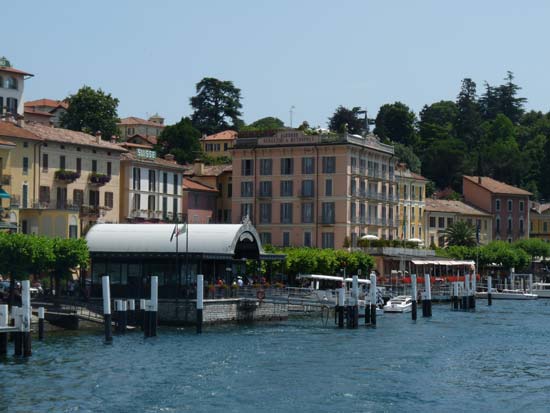
From the central waterfront, stepped and cobbled lanes rise up the hill in a tight little network separating the lakeshore from the town’s main street, Via Garibaldi. This is a pretty lane where you’ll find more shops, cafes and also Bellagio’s main town square, Piazza San Giacomo, or Piazza della Chiesa. The square is dominated by the town church, the Romanesque Basilica di San Giacomo, which is worth a visit for its frescoes and statues. Externally you can admire the attractive bell-tower and elegant apse. On the opposite side of the square is a medieval tower, once part of Bellagio’s now-disappeared defences and now a tourist office where you can buy tickets and rendez-vous for the tours of Villa Serbelloni’s gardens (highly recommended; see below). The fountain in the centre of the piazza is said to have been originally commissioned by a resident Englishman for his garden to commemorate Queen Victoria’s Diamond Jubilee.
Walking from the piazza past the church and out towards the tip of the Bellagio promontory, you reach a viewpoint, park and little harbour at Punta Spartivento, where the lake divides. Heading in the other direction from the square, Via Garibaldi passes the main entrance to Villa Serbelloni and reaches the town hall (Municipio). At this point a paved footpath (signposted) leaves the road and heads towards Pescallo, about ten minutes’ walk away. Pescallo is an enchanting little fishing hamlet looking out over the western Lecco branch of Lake Como, on the opposite side of the promontory to the main settlement of Bellagio. There’s a restaurant with tables right on the water’s edge, and although there are one or two hotels, the atmosphere here is low-key, charming and miles away from the smart, touristy world of Bellagio.
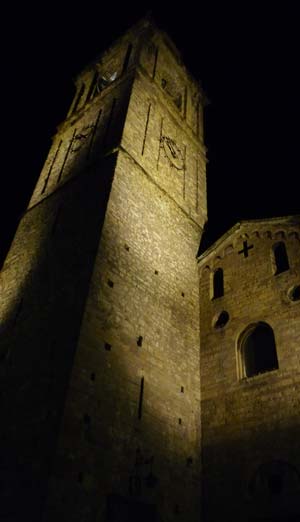
From Pescallo, following the ‘Bellagio suburbs’ walk suggested by the tourist office pamphlet, you pass by some agricultural ruins ripe for renovation, then the imposing, empty Villa Giulia and its dramatic ‘Vialone’. This is a wide grassy path cleared by an early owner of Villa Giulia, in order to give his house views over both branches of the lake. At the far end of the Vialone you can head left down to another waterside settlement, San Giovanni, where local teenagers sun themselves on the harbour wall and where the little town square is decorated with a ‘grotto’ constructed by the local priest in the 1950s as a shrine to the Madonna of Lourdes. There is also a rather specialist museum at San Giovanni, dedicated to navigational instruments (the Museo degli Strumenti della Navigazione). Back in the direction of Bellagio, the next little fishing harbour is Loppia, where you can see examples of the historic local lake boats. Try to get a glimpse of the old village church, now enclosed in the private grounds of Villa Trivulzio Gerli. The route back to Bellagio lies through (or by road around) the gardens of Villa Melzi, described below.
In the tourist season you may see a little tourist train (trenino) tootling by; this takes a 20-minute tour towards the hamlet of San Giovanni. It’s not a hugely scenic route as the roads don’t run along the lakeshore, but it is fun, especially if you are travelling with children. The departure point is indicated by a notice-board, near the car-ferry jetty.
Villa Serbelloni
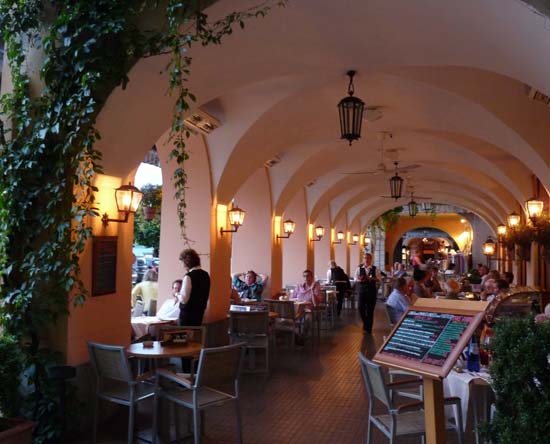
Villa Serbelloni is a large, grand building on the slopes of the Bellagio promontory. The villa’s grounds enclose the wooded hill behind the town, which dominates the headland and the centre of Lake Como. The villa building isn’t open to the public, but the gardens and grounds can be visited on organised tours, which take place twice a day. Tickets are sold before the commencement of the tour at the Promo Bellagio office in the little medieval tower in Bellagio’s main square, opposite the church. Numbers are restricted, so turn up promptly. Up-to-date info can be found on the tourist board website. At the time of writing tours run April-early November Tuesday-Sunday at 11am and 3.30pm, weather permitting (small discount for National Trust members).
The tour is a great way to start your holiday in Bellagio, as the villa’s grounds look out over the lake, offering panoramas you can’t see from the town. Our tour (in English and Italian, with an excellent guide) was very informative and gave context to what we would be seeing at Bellagio and around Lake Como, as well as providing ideas for further exploration. In addition to the views, you can also see the botanical plantings on the headland, various flowerbeds and ornamental water features, a grotto under the summit of the hill and the ruins of the old defensive fortress which once commanded the point, watching out over the lake’s three branches.
In the twentieth century the villa belonged to whisky heiress and princess-by-marriage Ella Walker, who left the property to the Rockefeller Foundation. The Foundation organises conferences and ‘retreats’ for scientists and artists, who work in the little ‘chalets’ dotted around the grounds. The organisation is very jealous of their privacy; guided tours avoid the attractive formal gardens nearest to the villa, and tourists are banned from taking photographs of the building while visiting the grounds. There is a lot of walking on the tour, mostly on gravelly paths, and you’ll want sensible shoes. Uphill sections are at a gentle gradient.
Villa Melzi
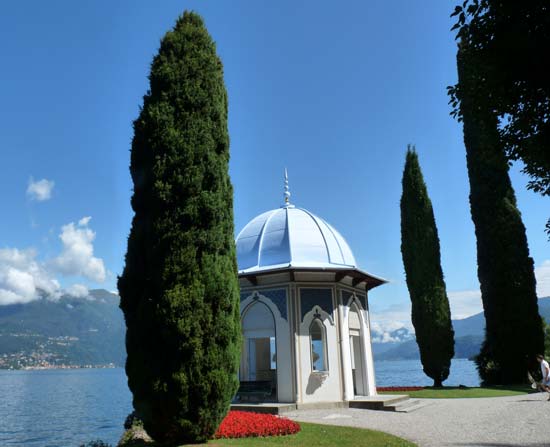
The garden of Villa Melzi doesn’t have the same historic significance as Villa Serbelloni, but it is a very pretty sloping garden along the lakeshore and is worth visiting if you are spending time in Bellagio. The villa was built for a nobleman of the Napoleonic era, and various mementoes related to the times are collected in the little orangery museum, along with church frescoes and archaeological oddments. Two of the prettiest features of the garden are a little blue-roofed pavilion at the water’s edge (one of the landmarks of this shore), and a shady water garden. There are entrances at both ends of the garden, close to the waterfront, and one of the walking-tour leaflets from the tourist office recommends a route which passes through the gardens. A ticket is valid all day, and you can also buy tickets valid for 3 or more days which are good value if you fancy returning to ramble about or take this picturesque route along the lakeshore.
Around Bellagio
You can spend a couple of slow-paced, pleasant days in Bellagio without feeling the need to move on. But the town’s position at the tip of Lake Como’s central promontory also makes it ideal for boat excursions to the towns on the two opposite shores. A good-value one-day boat ticket for the central part of the lake allows you to cruise around and hop on and off. Varenna, on the eastern shore, is a very pretty little village with two gardens to visit, a minuscule beach and outdoors cafes. Lenno, further down the western shore, is the boat-stop for visiting Villa Balbianello, just about the finest villa on the lake. Menaggio is a pleasant tourist town with an attractive seafront promenade. Another stop for garden-lovers is Tremezzo, home to the terraces of Villa Carlotta.
Ferry services run from Bellagio to all three corners of the lake, allowing tourists to visit a variety of little towns, or simply to cruise enjoying the dramatic views. Taking a ferry down to Como town makes a long but interesting day trip, as the boat passes the grandest villas on the lakeshore. Como itself is worth exploring, and you could return by the cheaper bus service; a twisting and panoramic journey which compares with the Amalfi Coast.
Private taxi and water-boat firms offer tours and excursions from Bellagio. For an unusual trip inland, visitors could try an organised walk high above the lake, accompanied by donkeys, with minibus transport to the start and a local lunch included (information available from the local tourist office). In the shops in Bellagio you can buy guidebooks for walking in the mountains around Lake Como, and in the winter there is a certain amount of skiing locally.
Bellagio travel and transport
Although Bellagio is stuck out at the end of a long mountainous promontory in the middle of a lake, it is actually quite straightforward to reach by road or public transport. Most of the lake ferries stop there, both the longer-distance ferries which run from Colico in the north to Como in the south, and the mid-lake shuttle, which connects Lake Como’s central resorts. A winding road runs above the lakeshore from Como town, and there are car ferries linking Bellagio with Varenna on the eastern shore and Cadenabbia on the western side of the lake.
The most convenient airports are Milan Malpensa and Milan Linate. From Malpensa you can buy a through ticket to Como Nord Lago station. Take the Malpensa Express train service and change at Saronno. The trains run every half-hour (at the time of writing) and the journey takes around an hour, plus a 20-minute wait at Saronno. Como Nord Lago station is right by the lakeside. Just cross the road and walk left along the lakeshore to reach the ferry ticket office and jetties. Over a roundabout from the end of the railway station is Como’s bus station, where you can buy tickets and pick up timetables. There’s a tourist information office in the same building. The C30 bus runs from a stop alongside the end of the train platforms and travels all the way to Bellagio, stopping close to the waterfront. This is a winding and very picturesque journey, with views over the lake and down over the rooftops and belltowers of steep scattered villages. It is rather like a gentler version of the Amalfi Coast bus ride.
Como Nord Lago station is connected to Milan Cadorna station by frequent trains, run by LeNord. The main Italian rail company, Ferrovie dello Stato (FS) operates from a different station, Como San Giovanni, with trains running a fast service to Milan’s Stazione Centrale. Como San Giovanni is on the other side of the town centre, up a steep flight of steps. It’s not so convenient if you are travelling onwards by ferry, but the C30 bus stops outside for easy land transport to Bellagio. Tickets and information about buses to Bellagio and to Como’s ferry stops are available from the newsagents inside the station.
Other options for arriving are by train from Milan’s Stazione Centrale to Varenna, then catching a ferry to Bellagio, or from Bergamo Airport via Lecco and Varenna. I would recommend using the detailed advice on the tourist board website (see links panel) and confirming the latest timetables online with the individual transport companies.
Eating and drinking
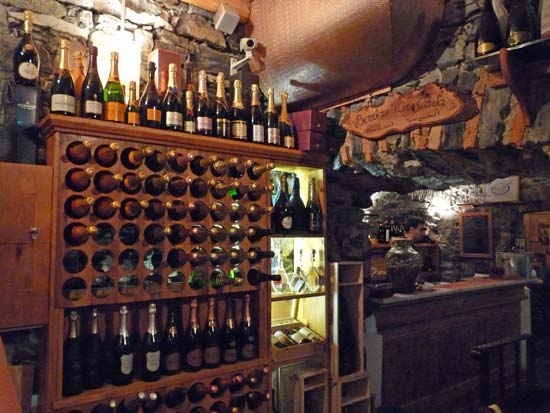
Bellagio has a good choice of fairly smart, decent restaurants aimed at its tourist clientele; as it has a very small resident population you won’t find many ‘local’ eateries. We enjoyed several meals at Far Out (Salita Mella, 4; see links), a slightly trendy restaurant with good pasta dishes, friendly waiters and (on our return visits) nice free extras. For a more homely atmosphere and satisfying pizzas you could try Barchetta, a few yards uphill. We also liked the Enoteca Cava Turacciolo (Salita Genazzini), an intimate cellar wine bar with tasting-plates of local meats, and cheeses with honey, as well as more traditional meals. If you are on a tight budget, you could try the reasonably-priced light meals and snacks at La Torre, a bar with tables on the main piazza. Along the town’s main street, Via Garibaldi, are some more cafes and a take-away shop selling pizza slices and snacks. If you fancy picnicking – or just saving money – visit the small food shop signposted ‘Mini-Market’ just below the church, where you can stock up on groceries or buy cheap rolls made to order. Like the other towns around Lake Como, Bellagio is generously dotted with drinking-water fountains where you can fill up a bottle or flask, so there’s no need to spend a fortune on mineral water.
Bellagio accommodation
Bellagio has been a classy and popular resort for over a hundred years, and it is an expensive place to stay. If you can afford it, though, it is lovely to spend your holiday in Bellagio, enjoy the views and wander the little lanes at your leisure. The little town centre is full of costly and rather old-fashioned, stately hotels. The grandest option is the five-star Grand Hotel Villa Serbelloni (a different building to Villa Serbelloni described above). We stayed in a smart two-star option with some lovely views, the Hotel Bellagio.
> Read my review of Hotel Bellagio
> More Bellagio hotels and B&Bs
On this site
Useful external links
LeNord (Milan-Saronno-Como trains)
